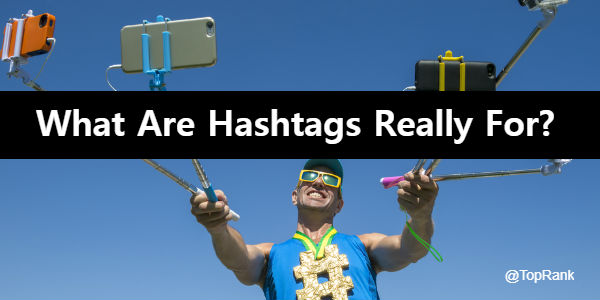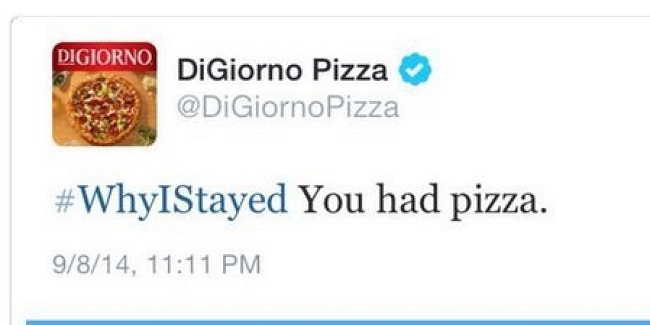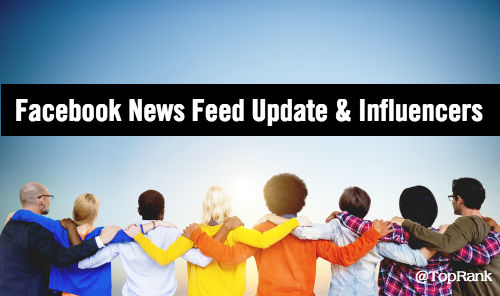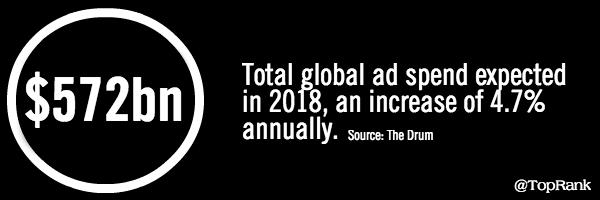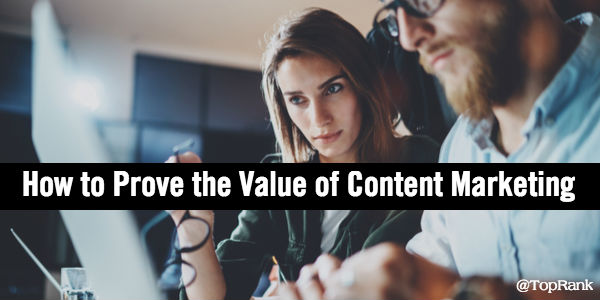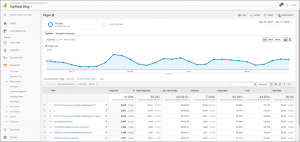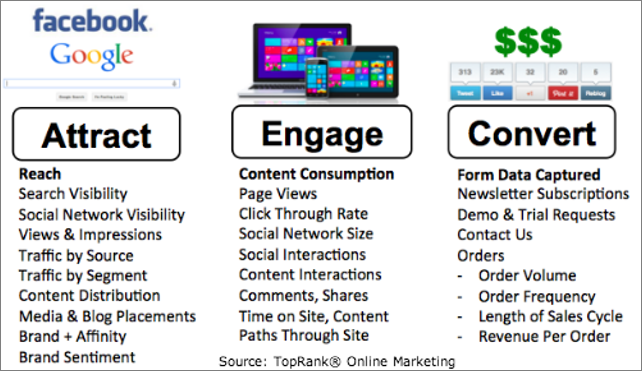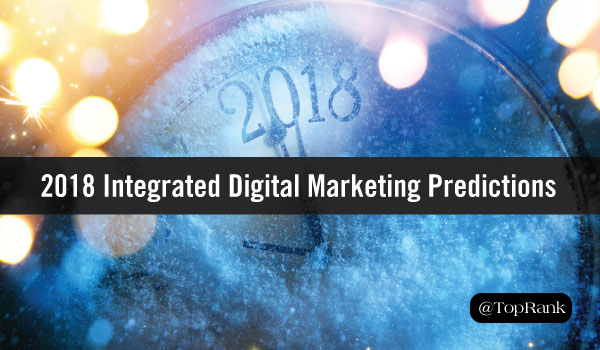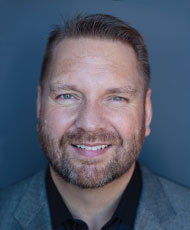In the inaugural episode of Marketers Talking Marketing Over Coffee, we have Rand Fishkin, the Founder and Wizard of Moz. For over 15 years, Rand has been a pioneer in the SEO industry, being a voice and sharing his observations when no one else did. We spoke to him to gain some of those insights.
Video Transcription
Adam Heitzman: Hello everyone, welcome to Marketers Talking Marketing Over Coffee. I’m pleased to have Rand Fishkin as our inaugural guest. Rand is the founder of Moz and a thought leader in the digital marketing space, and has been for the last 10-15 years.
Rand, thank you so much for being here today. I’m very excited to have you. Many marketers know who you are, but for those that don’t can you give me a brief introduction about yourself?
Rand Fishkin: Sure. Thanks for having me, Adam. Glad to be here.
So, I started a company that eventually would be called Moz. Started that company back in 2003 with my mom, Gillian, and over the next 10 years/15 years that company became one of the fastest growing softwares and service marketing companies, certainly in North America, maybe in the world. And then, a few years ago I stepped down as CEO. And for the next couple of months I’m still an individual contributor at Moz to product strategy and marketing those kinds of things. And, then I’ll actually be starting a new company in a couple of months here.
And, I’ve done a bunch of other things, I’ve co-founded Inbound.org with Dharmesh Shah from HubSpot. And, a lot of folks know me from Twitter and from my personal blog, as well as lots of speaking events and travel around the world.
Adam Heitzman: Awesome. Well, you know the purpose of creating this particular video series in general was really, with social media out there, and there’s so much noise, it’s often difficult for brand new marketers that are just coming in to, not only the digital marketing space, but the marketing space as a whole to identify and learn from true experts. There are a lot of people that come out and say, “Hey we’re an expert.” And, you never know who to believe and who not to believe.
So, kind of what the premise of this video series is, is to interview well-known thought leaders in the industry, so that we can provide that resource to those newfound marketers.
Rand Fishkin: Sure, sure, that makes sense. I don’t know if I’m an expert, but I’ve made many, many mistakes and hopefully I can help folks not make the same ones I have.
Adam Heitzman: Well, great. My first question for you, and it’s one I’ve always kind of wondered myself having followed you for so long: Who would you consider to be your single biggest influencer as a marketer?
Rand Fishkin: Oh, gosh. That was a great question. I think probably … it’s hard to say that it’s not family, right?
I think, in my case, probably my biggest influencer in my life is Geraldine, my wife. And, that certainly had a big impact on me professionally as well. But, outside of that, in the professional space, I think one of the people that I followed very early in my career and for a long time, and then have had a sort of friendly acquaintanceship with over the last few years is Seth Godin.
And, he and I share a lot of beliefs of how marketing can and should work, right? That relationships are there to be earned. That, one of the best ways to sell is to not sell anything, that being unique and having uniqueness as part of your product and brand is a wonderful way to stand out. And that building a small and passionate tribe is more powerful than having a big audience that doesn’t care much about you.
Adam Heitzman: Sure.
Rand Fishkin: So, there’s a lot of ethos-sharing that he and I have.
Adam Heitzman: Right. And that makes a lot of sense. And, you know honestly, Seth is somebody obviously that I follow a great deal about. I guess he just recently did a keynote speaking event, and I can’t remember the event was, and he spoke to a lot of those same concepts that you just mentioned. And, so yeah, he’s a great follow.
Not to take away from that. I honestly thought you were going to go, just based off my past experience of seeing you, and talking, that you were going to talk about your mom. And, I know that she’s probably been a major influence on you as well.
Rand Fishkin: Absolutely.
Adam Heitzman: One of the things that I recently re watched, an interview that you had done on Mixergy as well from years back. And, for those that haven’t seen it, I’ll link to it in the diatribe below. But, in that interview, you opened up about … in that consulting business that you had, you and your mom were working together on, that you ended up in almost $500,000 in credit card debt.
Rand Fishkin: That’s right.
Adam Heitzman: What did you learn about those mistakes from that timeframe. And, how did you use that from a positive standpoint to make sure you didn’t follow down that same rabbit hole with Moz?
Rand Fishkin: Well, so that company is the same company that became Moz eventually, right? I mean, we shuttered the old company and sort of started a new one, a new LLC at the time. But, it was merely a continuation of the same services we’d been providing to clients and that kind of thing.
The biggest lesson there was just that there were a lot of things that we tried that we thought would be effective to earn us business or retain customers, and they were not, because I think they were just window dressing. So, “Let’s get fancy office space. Let’s make sure we have a substantive staff,” which at the time meant five people instead of the two of us. “Let’s make sure that we’re going to trade shows and setting up booths.”
And, I think in each of these cases what we learned is you can have a scrappy, cruddy office above an old, dingy movie theater, which is where we moved to, and it was plenty loud. But, that doesn’t matter as long as your work is good, right? And, you don’t have to go to trade shows and exhibit in the booth if you can produce content that is so interesting and useful, and valuable that you’re invited to speak on the stage.
And, you don’t need a big staff so long as you, yourselves can accomplish the work, right? And, you can wait to hire until you have the clients and the money coming in.
So, a lot of things about the basics of operating a business that I think we didn’t get right. I don’t think there’s a ton of deep, powerful learnings there, other than, “Well, I was real young, and real dumb.”
Adam Heitzman: Right, yeah. And, I think you pointed out a couple things that kind of really resonate with us as well. And, ultimately it comes down to better understanding your clients and your customers, so that you can produce those results for them.
Rand Fishkin: Yup.
Adam Heitzman: Again, it’s less about the flash. It’s more about, at the end of the day, what can we do to help you achieve your goals, right?
And, so obviously Moz is in the software as a service business. And, knowing that, what strategies or tactics have you guys used to better understand your customers?
Rand Fishkin: Gosh, yeah. Well, I would say a lot of things over the years, And, I’m going to have more familiarity with this a few years ago, and they’ve actually passed them in the last couple months.
Some of the biggest and most powerful for me, were spending real, in-person time doing work alongside the people who are our customers. Or, who wanted to be our customers.
And, so one of the more outlandish things I did on this front was I spent a week in something that a friend of mine and I did called CEO Swap. So, basically Wil Reynolds, the owner and founder of an agency out in Philadelphia called SEER Interactive, I think they’re probably around 130/140 people now. I think they were just around 75 when I was CEO for a week.
We lived in each other’s houses for this week. I took care of his dog. I went to his charity events and I went to work, right?
Adam Heitzman: So, you went all the way?
Rand Fishkin: I answered his email, I was on all of his phone calls. And, I got training from his team and spent real time digging into client projects for them. And, that helped me to see a lot of things of how they did their work, what kinds of software and tools they used, when they didn’t use tools, what manual processes could be replaced with automated ones, what data they needed, how they investigated whether data was accurate, all those important things. I think being able to empathize with your customer by having their same problems is a really powerful thing.
I don’t know that I have anything better that I’ve done over my career to get inside the heads of our customers than that.
There’s lots of other things that we do. I mentioned to you early on that I do a lot of conferences and events, and certainly when I’m there I try to spend a lot of time watching other speakers, seeing what they’re talking about, and using and showing off. As well as talking to folks in the audience and see what they’re doing, stopping by booths and seeing what software providers are offering and those kinds of things.
Moz also has a formal usability testing program, where we invite folks into the office and we also remote screen-sharing usability tests and surveying and all the sorts of things that you might expect of a mid-size software company.
But, I really like having those personal relationships. I think there’s no substitute.
Adam Heitzman: Yeah. Absolutely. And, then you’re able to take all of that information and use that not only to develop the products, but actually market it to the correct audience, speaking to those pain points that you’ve learned along the way.
Rand Fishkin: Yeah. Hopefully. I think one of the tough things is, and I think this is just the way people are wired. As an organization scale, it starts to build processes, and a lot of the times the processes require like statistically significant data.
So, we conducted ten usability tests and two people told us that this wording, this language was confusing for them, or they didn’t know what it means. And, so that crosses our threshold of, “We need to change it,” as opposed to, “Well, I spent a ton of time with these people, everyone will get it. We’ll be fine. This is the right language to use.”
And, getting for us to trust intuition over data over design process is very easy when you’re small, and very difficult when you’re larger. So, I think that one of the things that I would say for product designers and folks who want to build something in the software space, and even for marketers who are trying to build projects for their clients, you have to decide how much you want to be artistic and internally driven by your preferences and know how, and how much you trust yourself or your team to do that. Or, how much you want to build process into the system so that you have more statistical types of data and rules around those.
And, I’m definitely somebody who operates better in the, “Strong intuition, in my opinion is better than a data heavy process.”
Adam Heitzman: To each their own I guess.
Rand Fishkin: But, scholars disagree, right?
Adam Heitzman: One of things that I always wondered, I’ve been in the SEO industry now dating back to roughly 2004/2005. And, back then, even before then, everything was so secretive.
Rand Fishkin: Yup, I remember that.
Adam Heitzman: It still, to some extent is, but one of the main reasons that I’ve grown personally in the digital marketing and SEO space is because of you.
Rand Fishkin: Thanks.
Adam Heitzman: You were arguably the first public figure to be open about what works and what you’ve learned along the way. And, so first off, thank you.
In some ways, do you feel like that transparency that you’ve instilled has been a marketing tactic that’s actually helped Moz grow to what it is today?
Rand Fishkin: Yeah. I mean, I would say transparency has strengths, it also has plenty of weaknesses and drawbacks too. The reason Moz did it during my tenure there was not because it was a tactic or it was strategic, but because it was a core value.
Adam Heitzman: Sure.
Rand Fishkin: And, I think a core value is something that you aren’t willing to sacrifice even when it harms the company, you value it above money, above growth. And, that is certainly true for us and transparency. Well, I should say was true for us and transparency.
I think as Moz is evolving in the future as I move onto other places, I think that might change for sure.
It’s a tough call. So, I think the transparency, by being very open, especially early on in the SEO world when things were so secretive, when so few people were willing to be transparent about what worked and what didn’t and why, and the how’s behind things. Google was extremely secretive, the other search engines were too ’cause they were all in this war against each other. And, so they didn’t want any of their secret sauce leaking out. That time period made it incredibly frustrating to learn the practice of SEO and to know if you hired a good SEO, if you trust the person that you had hired to do SEO. And, search was this incredible channel, and still is this incredible channel for driving traffic, but was so obscure and inaccessible that Moz’s … at the time, my personal blog’s transparency really made a huge dent.
It’s been interesting to see. There’s drawbacks to that too. So, over time Moz’s has had a number of copy-cat competitors. And folks get into the field because they sort of saw … and we published our revenue numbers, we published all of our metrics numbers, we published exactly how we collect all of our data and what we do. And, so we’re a very, very easy company to reverse engineer. And, I think certainly some folks took advantage of that, some have even built on top of it very effectively.
But, this was a trade off we were always going to make. So, it’s something for everyone to choose, but can transparency be a great marketing tactic? It can.
Adam Heitzman: Honestly, from my perspective, I think it’s helped you guys tremendously. Obviously that is what drew me to you guys, that’s what drew me to you. I’ve appreciated it through these years.
Adam Heitzman: According to the Moz reader survey, I think y’all just did, what a week or two ago?
Rand Fishkin: Yeah, A few weeks ago.
Adam Heitzman: One of the greatest difficulties faced by SEOs particularly is explaining its value and also properly setting the expectations of the results. I know it’s something we deal with as an agency on a daily basis ourselves. And, so I’d love to hear from your opinion how can this be done effectively.
Adam Heitzman: It’s like a million dollar question, but-
Rand Fishkin: I think one of the challenges is so much of digital advertising, where you pay and traffic comes to you, is incredibly measurable because the channels that offer it. So, Google’s Ad platforms and Facebook’s ad platforms and Twitter’s and all the rest, they have a huge vested interested in making sure that you can clearly, obviously see and easily calculate the return on your investment.
Organic is just the opposite. Google wants to make that very difficult for you to invest in, so that you’ll spend money on paid search instead, and not try so hard to game their systems and not try so hard to write because they kind of prefer that you just took a hands off approach and let them figure it out in a lot of ways.
So, this is an adversarial form of marketing intelligence that we’re trying to get to. And, that’s at the core of the difficulty.
So, for example, every time Google sends you a visitor in AdWords they will tell you exactly what keyword that visitor searched for, what position you were when they clicked on you, which version of your ad was showing, what they did on your website after that visit, all these things.
If they come from organic search, they’ll tell you, “Well, they landed on this page.”
Adam Heitzman: Right.
Rand Fishkin: The rest is up to you. Like, “Good luck with that.” They took away keyword data through the “Not provided” fiasco, which is a bunch of hypocritical crap. But, the way to get this data back is to build sophisticated models, unfortunately that requires some investment, but it is totally possible.
So, in the weeds of it, we can say, “Hey, look we can show you when visitors come to your website from organic search. Here’s what happens next. Here’s the percent of them that come back for a second visit, or come back for more visits in the future. Here’s what percent of them eventually make a conversation, actually buy something or give you their email address, or sign up, or do whatever it is you want them to do on your website.” And, so now we can quantify organic search as a channel and say, “Hey, all organic search is valued at X.” And, we can try to get more sophisticated by reversing out branded search keywords, the ones for which your homepage, or product pages are most likely come up versus the non-branded searches where you’re really competing against everyone else in those.
As you get those levels of sophistication, you can show that data more and more clearly, but I think the process of explaining this to clients is the tough one. It’s that first conversation of, “This will be hard to measure. We’re going to have to do a lot of work to do it. Because it’s hard to measure, fewer people will invest in it. That means the competition is less, and the potential return on investment is much higher than it would be with paid search or any other form of paid advertising.” And, convincing a client to “say, Oh my gosh, you’re right.” That’s such a powerful opportunity because it’s so difficult to measure. I think that’s where the eureka moment can come in.
But, you have to earn that buy-in through those early conversations. It has to be sort of a strategic thoughtful exercise whether they get their minds over it at the highest levels of the company so that they believe in you and they say, “Yeah, we’ll give you six months to show the ROI that you’re going to show.”
Adam Heitzman: Sure, I think that’s one of the things too, and that’s not just with us, I think that’s the case with pretty much any agency out there. It’s all about having those conversations on the front end to be able to set those expectations. And, sometimes the client might not be worth, or may not be the right client for you, right?
Rand Fishkin: Right, absolutely. I think one of the great conversations to have early on is to say, “Now, you’ve got this budget, we can invest it in paid channels, they’re high competition. The ROI will be lower, but it will show you returns right away, and we’ll be able to track in detail everything that is producible.” So, if you’re very addicted to those numbers, you need it early on, you need to be able to show returns really quickly, let’s do paid.
However, if you’d like to have a conversation about organic, just be prepared, it’s going to be three to six months of investment before it starts to show return. It’s going to be tough to measure. We’re going to show a lot of correlated metrics, but it’s not going to be directly causal the way paid is, because we can’t track on a one-to-one basis in the same fashion. So which one do you want to invest in?
Adam Heitzman: Sure.
Rand Fishkin: And, having them choose, “No, we want the lower ROI channel that makes us feel more secure.” Or, “yeah, we’re up for the challenge, let’s take some risk, let’s go for this bigger opportunity.”
Adam Heitzman: Yeah, and actually I think just yesterday you had posted all that data from Jumpshot. And, so it appears that organic is still far superior to the paid in terms of … even with Google’s recent changes on adding a forth ad to the top and moving it from the right reel to straight on top. That organic is still leading the way by a vast margin.
Rand Fishkin: Yeah, I think this is the fascinating part of Google’s journey over the last 15 years is that while Google has gotten more and more aggressive about the advertising, where it appears, how subtle it is compared to the organic results, all those other kinds of things, the click-through rate at least broadly speaking on ads versus organic has remained really similar. So, I showed charts yesterday that were basically over the last two years we’ve essentially had a stable amount of paid clicks per 10 search queries across Google.com, at least in the US where the advertising is most aggressive.
And, organic results, it was I think around 7 clicks per 10 queries, and now it’s down to about 6.6 or 6.5. So, it’s a little bit lower than what it was two years ago, but still 20 plus times as much as paid.
Adam Heitzman: Sure.
Rand Fishkin: So, someone says to you, “Oh, I really want to invest in search. Should I do paid or should I do organic?” I think the smart answer is probably both. But, just be aware that paid drives across google 5% or fewer of the clicks that organic does.
Adam Heitzman: Yeah. I think one of the connections that you made kind of leads to one of my next questions. Is that, even though there was a drop slightly in terms of … from 7 out of 10 down to 6.6. Now, some of that correlation is due to some extent featured snippets and providing those answers on the front end and users not having to click on the listings themselves. Is that correct?
Rand Fishkin: Yeah, yeah. That’s right. So, it’s not that people are clicking on paid more, they’re clicking on paid just about the same amount, it’s that they are clicking overall less, because Google is answering so many queries right in the search results.
So, the percent of searches without any click has gone up, I think about 20% over the last two years. And, it’s now just under half of all queries are essentially solved without a click.
Adam Heitzman: Right. Now, I’m asking you to kind of put your Nostradamus type of hat on here. Obviously with voice search in its infancy, what role do you think it’ll play in the future? Meaning, do you think it’ll start accounting for a larger portion of queries than what it does now?
Rand Fishkin: My perspective on voice search is that I don’t really care, and it doesn’t matter.
The reason being that whether you input your … If I take my mobile device and I type in my query or I say, “Okay Google, what is blah blah blah.” If they show me results on a screen, a desktop, a laptop, a mobile screen, a tablet screen, whatever it is, it doesn’t matter how the query was inputted. What matters is how the query results are output.
Now, what I worry about, what I have great fear is voice answers. So, voice search, doesn’t matter. Voice answers, I think that’s a real cause for concern. And, basically one of the reasons that we looked at Jumpshot data and asked them to collect it is cause we want to say, “Hey, over the last two years we’ve seen a huge rise in voice answers,” Voice applications, Alexa, and Google Home, and all these kinds of things. And, so we want to know are searches that results in a screen of results, are they going down over time? And, the answer is no, they are going up. We’re about 15% higher year over year, this year than last year, and last year than the year before. So, growth continues. And, it looks to us like voice answers and all these home devices and all these sort of things are additive, not cannibalistic.
Which, interestingly that’s the same thing that happened when mobile came out around desktop. So, desktop and laptop searches they plateaued in about 2012/2013, somewhere around there. And, they’ve been growing, but only very, very slightly. But, mobile has continued to grow very dramatically. And, I think we’re going to see the same thing with voice answers. That search will plateau, it’ll level off, I don’t know if the growth rate will stay 15%, maybe it’ll drop to 10%, whatever it is. But, I suspect voice answers will just be additive on top of everything else already.
Adam Heitzman: Okay, that makes sense. For a great deal of time, and probably still links have always one of those larger ranking factors in Google. Do you feel like, obviously you termed that phrase “User task accomplishment,” do you feel like that is starting to overtake or has it already overtaken the power of links? I feel like there is a good balance that you kind of have to have a strong correlation of both to succeed online now.
Rand Fishkin: Yeah, I absolutely agree with that. You need both to success. Right now, links, at least in competitive search results are still a big differentiator. So, thinking or assuming that you don’t need links, so you can stop caring about them is a fallacy. That is even more true in non-English language Google search. So, you get outside the US, UK, Canada, Australia, New Zealand you’re gonna find that it’s even more the case that links are the overwhelming ranking factor in a lot of these places.
But, that being said, I do see search or task accomplishment as on the rise. Certainly three years ago we were barely thinking about it, and today I think any SEO who doesn’t include it as part of their on-page optimization strategy is doing themselves or their clients a disservice.
So, we’ll see over time. One of my suspicions is that a good way that Google figures out why their page solves a searchers query comes from the links. Right, So by solving searchers queries well, you earn links that Google can interpret as votes for, “This helps me accomplish this task.” So, I’m not sure that those will ever become entirely disconnected. But, I think we still have … I can’t imagine we have less than 3 or 4 years left where links continue to be a very powerful signal.
Adam Heitzman: Sure. One thing that we specifically, and I’d love to kind of get your input on it, just from having run Moz for as long as you have, one of the things that we sometimes have difficulties with, especially as we hire new employees, or even employees that stay with us for some time, it’s the internet marketing industry as a whole changes so often. There’s a lot of new data, new information that’s constantly coming out. For example, two/three weeks ago obviously Google’s changed to expanding the snippet count to roughly 300 or so. With all these changes happening so often, how do you communicate, or did you communicate that and build that in your infrastructure for your staff to be able to stay on top of these ever changing trends so that they were able to build things, different software solutions to meet the needs of that. Or, anyone that was dealing with some of your customers. Can you kind of talk to that for a little bit?
Rand Fishkin: Yeah. So, I think we had basically at Moz there’s two communication channels that are heavily used for those types of discussions. One is Slack, where there’s a few different channels depending on which group you want to talk to. And, the other one is there’s email lists one of them is SME’s- Subject Matter Experts- which basically just means SEOs now.
And, a bunch of folks are on that list, and they’ll take discussions and they’ll push conclusions or research or whatever over to product.
And, then the other one is Industry, there’s an industry alias that sort of talks about what’s going on in the industry, what’s the news. Those sorts of things.
And, and that has been reasonable for Moz. One of my regrets in building the company, is I wish that I had hired staff and trained a much more significant percentage of the company around SEO specifically. One of the great things that Moz did is hired high-quality people in a lot of their areas of expertise. So, great designers who understand the world of UX and UI, great product people who are good product managers, engineers who understand technology, and those kinds of things. But, upgrading their knowledge and passion for SEO has always been a struggle. And, I remember for years I’d give like seminars about SEO as Moz and attendance was very poor, let’s say. A handful of people would come to that sort of thing.
It was interesting how building an SEO software company people cared about the software, a lot of the other aspects, but not as much the SEO portion.
Adam Heitzman: Right. Well, interesting.
Rand Fishkin: Yeah.
Adam Heitzman: One of my last questions for you is: For those new marketers that are just beginning their careers or just starting out. What advice can you give them as they begin their careers?
Rand Fishkin: Yeah, I think one of the smartest things that you can do for your career today, particularly if you’re in digital marketing is to specialize. And, that is to say, find an area where you have some personal passion, develop some unique skills and experience in that area and work to build a network and a reputation that broadcast and amplify that niche experience. So, I think it’s really tough to say today, “I’m in an expert in SEO,” and have everyone say, “Oh, okay. Well that person is very authoritative in SEO.” It is much easier to say, “I am an expert in early stage consumer startup SEO.” That is a unique niche. There’s plenty of companies in that space. But, it’s a hard one to tackle, it requires whole different skillset than B2B or later stage or agency side or consultant stuff. That is clearly a specialization, and if consumer businesses are what you love and you love those early stage and being very scrappy and designing sort of a content strategy from scratch, an SEO strategy from scratch and you’ve got some people that you’ve worked with you can point to and say, “Hey, they’ve been successful, so yeah I can do this.” That’s a really powerful thing for your career, and I think that can certainly help you accelerate a trajectory for what you want to accomplish in your professional life.
Adam Heitzman: I think that makes a lot of sense. You can’t be everything to everybody, right?
Rand Fishkin: Yeah. Especially as this world gets bigger, and bigger and more dense with talent, it’s tougher, and tougher to stand out in a field like digital marketing, or SEO, or social media marketing, or content strategy, or whatever it is. But, specialization is a great way to do that.
Adam Heitzman: Awesome. Well Rand, that’s all I had for you today. Thank you so much. It’s been an absolutely pleasure and honor. I know you’re leaving Moz in few months and starting on your new venture. So, good luck with everything. Obviously we’ll keep an eye on yeah. I know you also have a book coming out, is that true?
Rand Fishkin: That’s right. Lost and Founder is coming out in April.
Adam Heitzman: Awesome. Okay. Well, we’ll be on the lookout for it.
Rand Fishkin: Awesome. Thank you Adam. I appreciate it, take care.
Adam Heitzman: Thank you Rand, appreciate it. Take care
The post Marketing Insights from Rand Fishkin: The Wizard of Moz appeared first on HigherVisibility.
The post
https://www.highervisibility.com/blog/marketing-insights-rand-fishkin-wizard-moz/ appeared first on
https://www.highervisibility.com


